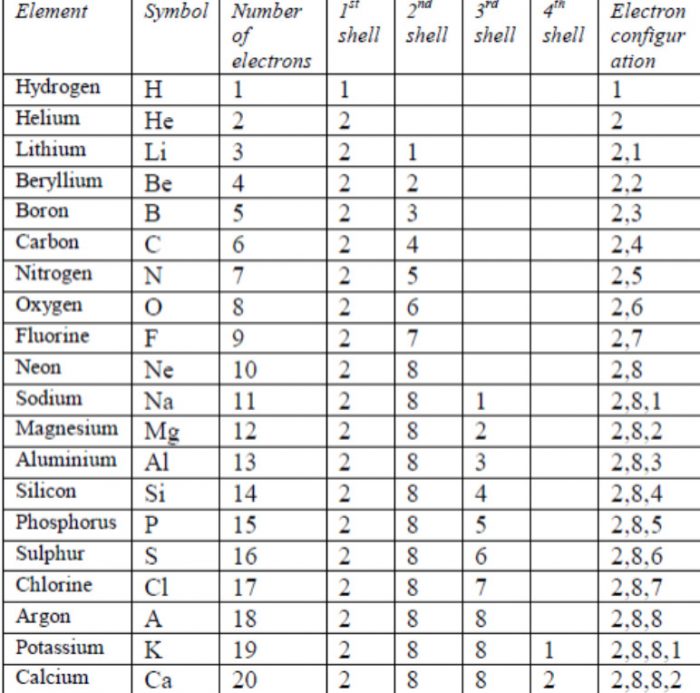

The atoms along the right edge of the periodic table are called noble gases. Learn shorthand for writing long electron configurations. For instance, the first row of the d orbital block corresponds to the 3d orbital even though it's in period 4, while the first row of the f orbital corresponds to the 4f orbital even though it's in period 6.

Caution: the d and f orbital regions of the table correspond to energy levels that are different from the period they're located in.Thus, its electron configuration will end. It's also in the fifth column of the periodic table's p orbital block. For example, when writing an electron configuration for Chlorine, think: "This atom is in third row (or "period") of the periodic table.Specifically, the 2 leftmost columns represent atoms whose electron configurations end in s orbitals, the right block of the table represents atoms whose configurations end in p orbitals, the middle portion, atoms that end in d orbital, and the bottom portion, atoms that end in f orbitals.Use the periodic table as a visual guide to write configurations – the order that you add electrons to orbitals corresponds to your position in the table. For example, atoms in the second column from the left always end in "s 2", atoms at the far right of the skinny middle portion always end in "d 10," etc. You may have already noticed that the shape of the periodic table corresponds to the order of orbital sets in electron configurations. Use the periodic table as a visual shortcut. Note that the above list, if all the shells were filled, would be the electron configuration for Og (Oganesson), 118, the highest-numbered atom on the periodic table-so this electron configuration contains every currently known electron shell for a neutrally charged atom.An electron configuration for an atom with every orbital completely filled would be written: 1s 2 2s 2 2p 6 3s 2 3p 6 4s 2 3d 10 4p 6 5s 2 4d 10 5p 6 6s 2 4f 14 5d 10 6p 6 7s 2 5f 14 6d 107p 6.Once you know the order of orbitals, you can simply fill them according to the number of electrons in the atom. For instance, a filled 4s 2 is lower energy (or less potentially volatile) than a partially-filled or filled 3d 10, so the 4s shell is listed first. Note that orbital sets are numbered by electron shell, but ordered in terms of energy. Remember the order of the letters with this mnemonic: Sober Physicists Don't Find Giraffes Hiding In Kitchens.The h set would have 11 orbitals and a maximum of 22 electrons, the i set would have 13 orbitals and a maximum of 26 electrons, and the k set would have 15 orbitals and a maximum of 30 electrons. The g set has 9 orbitals, so it could theoretically contain 18 electrons. No known atoms have electrons in any of these orbitals. The g, h, i and k orbital sets are theoretical.The f orbital set contains 7 orbitals, so it can hold 14 electrons.The d orbital set contains 5 orbitals, so it can hold 10 electrons.The p orbital set contains 3 orbitals, and thus can hold a total of 6 electrons.The s orbital set (any number in the electron configuration followed by an "s") contains a single orbital, and by Pauli's Exclusion Principle, a single orbital can hold a maximum of 2 electrons, so each s orbital set can hold 2 electrons.Each set of orbitals, when full, contains an even number of electrons. The Pauli Exclusion Principle arises from more than just the electrostatic repulsion of negative electrons: it comes from fundamental physical principles that constrain all subatomic particles.What is an atomic orbital? As an atom gains electrons, they fill different orbitals sets according to a specific order. The reason that electrons tend to stay in their separate orbitals rather than piling on top of one another is the Pauli Exclusion Principle, a theorem from quantum mechanics that dictates that no two electrons can ever be in the same place. This results in beautiful geometric structures called orbitals that represent the distinct regions around the nucleus that each electron traces out. While these electrons all stick within the atom because of their attraction to the protons, they also mutually repel each other, causing them to spread out around the nucleus in regular patterns. As we know, the positively-charged protons in the nucleus of an atom tend to attract negatively-charged electrons. Electron configurations are a simple way of writing down the locations of all of the electrons in an atom.


 0 kommentar(er)
0 kommentar(er)
